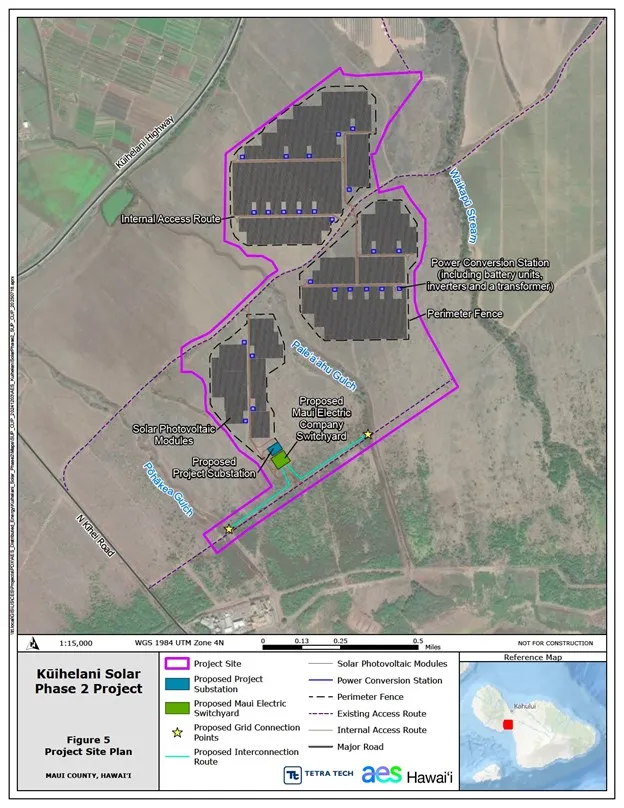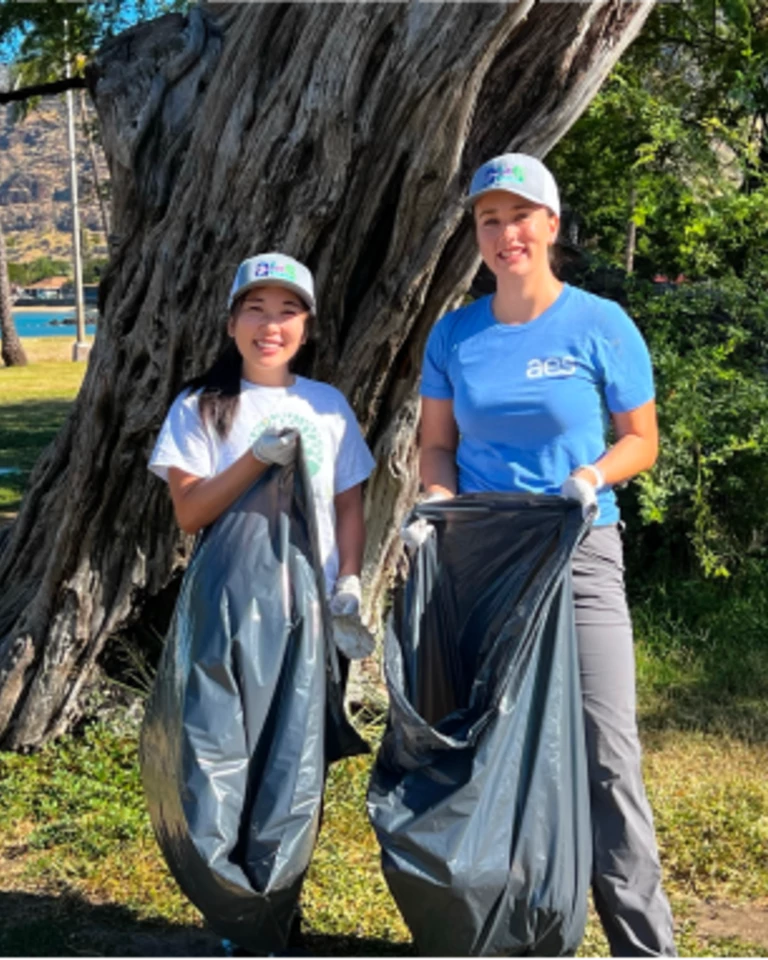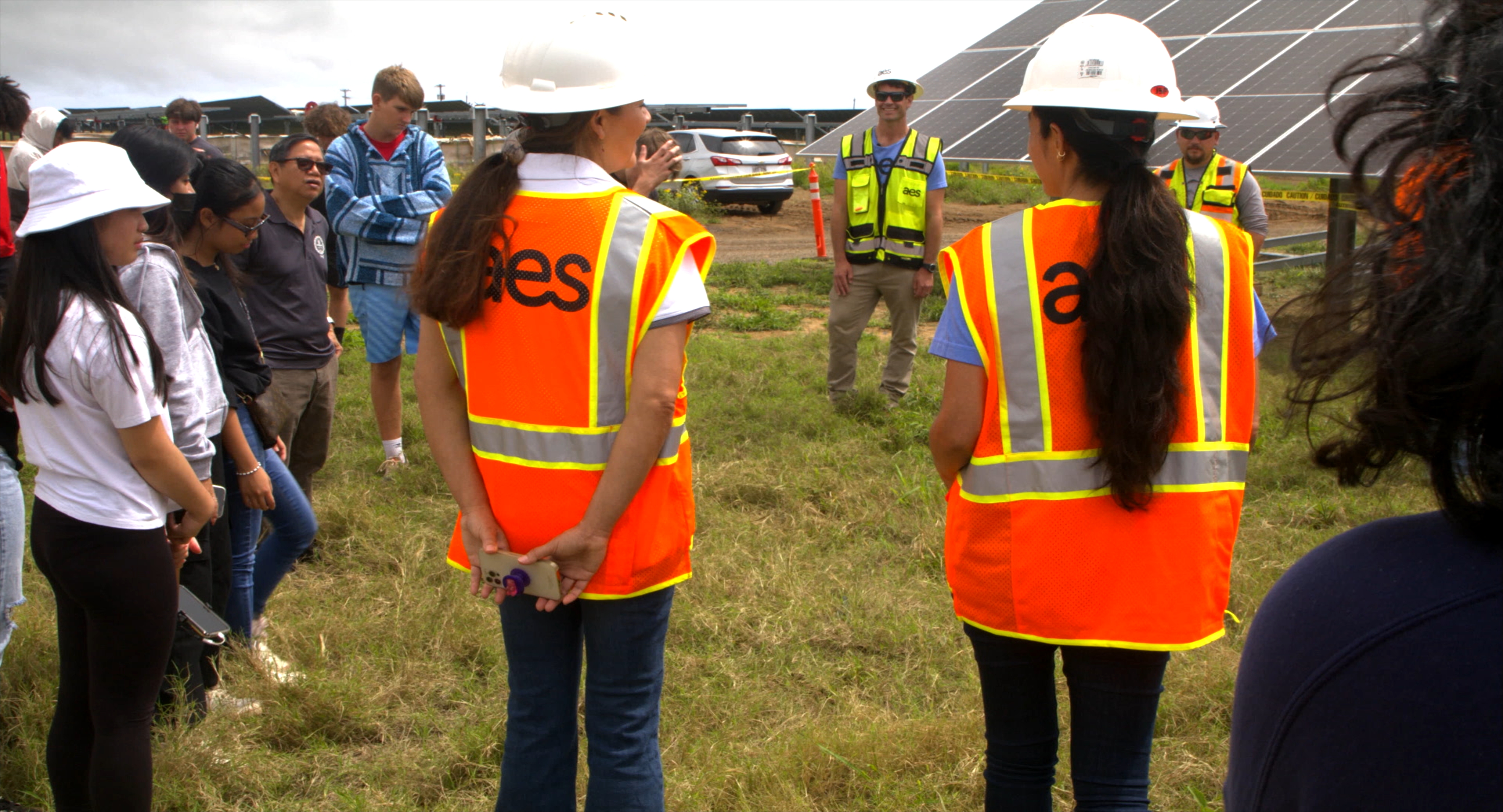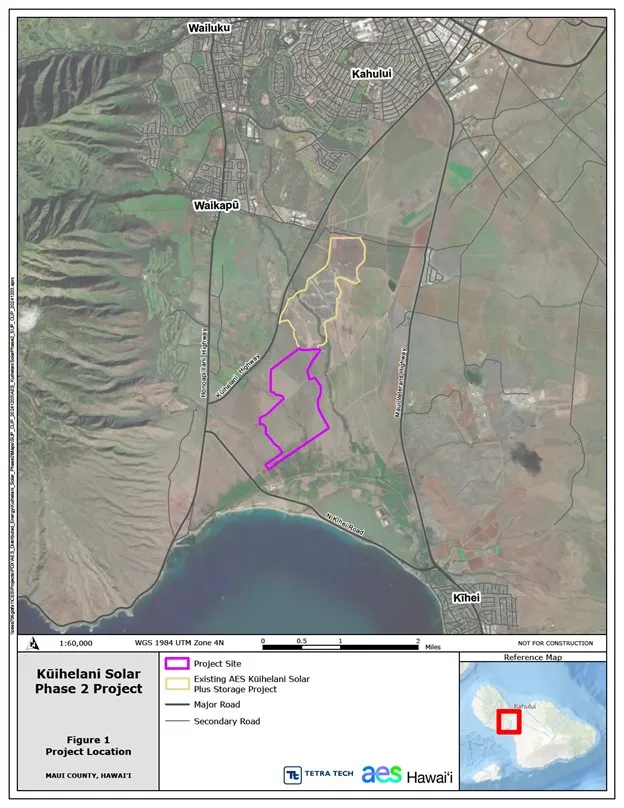Hawaiʻi’s 100% clean energy future
As Hawaiʻi accelerates its transition to a 100% renewable future by 2045, AES Hawaiʻi is partnering with utilities, communities, landowners and customers to deliver greener, smarter energy solutions and help ensure a responsible and equitable transformation to clean energy. Since the 1980s, our people have worked passionately to meet Hawaiʻi’s growing energy needs. Working together, we are co-creating solutions that support Hawaiʻi’s renewable generation goals, stabilize rates and increase grid reliability.
Contact us
We appreciate your interest and participation in Hawaiʻi's renewable energy future. We look forward to hearing your ideas and comments.
Community Outreach Representative:
Carrice Gardner
Email: kuihelani2solar@aes.com
Project Hotline: +1 (808) 800-3942
Project summary
Kūihelani Solar Phase 2 is a proposed 40 MW solar photo-voltaic array and 160 MWh containerized lithium-ion Battery Energy Storage System (BESS) project to be developed and operated by AES Hawai‘i.
The Project will be located in Central Maui, approximately 3 miles south of Kahului, on land owned by Mahi Pono.
- Specifications: 40 MW solar photovoltaic array plus 160 MWh containerized lithium-ion Battery Energy Storage System (BESS).
- Power-Purchase Agreement: The Project will deliver power to serve Maui residents under a Power Purchase Agreement with Maui Electric (MECO) at a low, fixed cost over its operational span.
- Decommissioning: All project components will be removed and the land will be returned to its existing condition (or comparable) at the end of the Project's operational period.
- Project permit area: The Project will be sited within a Project Permit Area of 476.303 acres, or approximately 12% of the 3,898.056-acre land parcel where it is located.
- Footprint of project components: Solar panels, batteries, substation, and other primary project components are designed to occupy an area of approximately 250 acres, or approximately half of the total Project Permit Area.
- Compatible agriculture: The Project will include compatible agriculture activities in partnership with local farmers and agricultural operators. The compatible agricultural uses are envisioned to include livestock and honey production - activities that require minimal water while helping Hawai‘i and Maui achieve both their renewable energy and agricultural goals.
Project site plan

The anticipated duration to achieve critical project milestones is included below. Please note: durations may run concurrently and are subject to change.
| Milestone | Anticipated Duration |
|---|---|
| Preliminary design and early community consultation | 18-24 months |
| Discretionary entitlements and approval process (County and State special use permits) |
6-12 months |
| Final engineering and design | 6-18 months |
| Ministerial permit approval process (NPDES, Plan Review, Grading, Building, Electrical, etc.) | 6-18 months |
| Mobilization, component deliveries, and construction | 16-24 months |
| Commissioning, energization, and final system testing | 8-12 months |
| Target Commercial Operation Date | EOY 2028 |
| Commercial Operation Period | 20 + years |
| Decommissioning | 12 months |
| NOTE: Certain durations may run concurrently |
AES Hawaiʻi is deeply committed to being an active, invested member of the communities we serve.

AES Hawaiʻi has a track record of successfully and sensitively engaging with the community and stakeholders near the proposed project.
Continuing to identify communities and other interested stakeholders affected by the project is an essential part of project planning. Upon award, the AES Hawaiʻi team began engagement with area organizations and leaders to provide timely and relevant project information and collect feedback to refine and finalize the Project’s design with community input.
AES Hawaiʻi's standard practice is to invite stakeholders to help identify others in the community who should be contacted, enabling the Project team to continually expand its outreach. AES Hawaiʻi also welcomes input on stakeholders to include in outreach efforts through the Project website and hotline.
-
Early stage outreach
-
AES Hawaiʻi conducted early-stage outreach by commissioning a public opinion survey to understand community sentiment regarding the proposed Project and identify issues of importance.
The public opinion poll provides initial documentation of the community’s support for the Project. Of the Maui residents who responded to our survey, the majority (70%) said they would support a similar solar and battery storage project in Central Maui. The majority of residents who supported the Project cited that it would be good for the environment or climate and would reduce the cost of electricity. Similarly, more than half support the Project because it would help to cut down on fossil fuel use. Other key reasons for support of the Project include the understanding that it would create new jobs and be good for the community and the economy. These results will help shape our strategy for communicating the Project’s overall benefits.
During our ongoing community engagement process, AES Hawaiʻi will directly engage with stakeholders and seek feedback regarding the Project. This process seeks to provide clear information about the Project and gives AES Hawaiʻi the opportunity to hear community-identified concerns about project design, location and potential impacts.
Image
-
Comprehensive communications plan
-
A significant goal of AES Hawaiʻi's Community Outreach Plan is to inform stakeholders and neighboring communities about the Project and its progress and collect their feedback. AES Hawaiʻi will continue to build upon our previous experience to provide timely updates through a comprehensive community outreach schedule. AES Hawaiʻi is committed to sharing important information about the Project in advance of any community meetings. Specific tactics used to share information and gather input will include, but are not limited to:
- Issuance of Public Community Meeting Notice(s)
- Conducting Public Community Meeting(s)
- Conducting strategic outreach to area organizations, community leaders, and elected officials
- Dedicated Project email address (kuihelani2solar@aes.com) to gather input, comments, and questions
- Dedicated Project phone number (+1 (808) 800-3942)
- Construction and status updates will be posted on the Project website (https://www.aes-hawaii.com/hawaii/project/kuihelani-solar-phase-2)
- Issuance of monthly project status updates to our Project mailing list; and
- Public Community Meeting Summary posted to the Project website.
Our ongoing community outreach efforts include updating stakeholders and neighboring communities about the Project and answering questions.
AES Hawaiʻi will continue to plan for either in-person or virtual community meetings as requested. To support community awareness, AES Hawaiʻi will continue to inform interested parties about such meetings. Communications tactics may include issuance of media advisories a minimum of 30 days prior to a public meeting to Maui and statewide media, including but not limited to: Maui News, Maui Now, Civil Beat, Hawaii News Now, KHON2 News, and KITV4 News. Additionally, we will advertise in area community publications and provide email notifications to stakeholders and those who have signed up for updates through the Project mailing list.
Public comments in support of and in opposition to the proposed Project are compiled and shared with Hawaiian Electric, to be filed with the Public Utilities Commission.
AES Hawaiʻi believes in the importance of maintaining community collaboration and consultation throughout the project lifecycle and has successfully implemented this strategy with Hawaiian Electric Company's RFP Phase 1 & 2 projects. Throughout this process, collecting, considering, and responding to feedback from stakeholders and neighboring communities has enabled AES Hawaiʻi to garner support and tailor each Project to address and mitigate community-identified issues or concerns.
One of the earliest steps we take when undertaking a new project is to engage area community leaders, elected officials, residents, key government and industry organizations, and businesses. This approach enables AES Hawaiʻi to share information about the Project, build support and develop mitigation measures for community-identified issues of concern.
Construction related updates
AES Hawaiʻi is committed to providing project status updates via email to our Project mailing list, at least once per month and in conjunction with key milestones to ensure community members and stakeholders have the opportunity to provide feedback as required by the RFP.
-
Community benefits
-
AES Hawaiʻi understands that each community in Hawaiʻi is unique, with different issues, priorities, and needs. As outreach continues, the Project Team will gather input and feedback to further refine the design and inform future engagement. A Community Benefits Program (CBP) has been established that will distribute $3,000 per MW per year of operation to fund priority needs of the community for the Kūihelani Solar Phase 2 Project.
Early-stage outreach has already provided preliminary insight into the type of community benefits Central Maui residents value most. During each meeting with the broader public and community leaders, the Project Team has explicitly requested feedback from participants on possible organizations, programs, and/or projects that should be considered as potential beneficiaries of the CBP.
As outreach continues, the Project Team will continue to consult and solicit feedback and guidance from the community on where these funds are needed the most. This feedback will form the basis of the CBP, ensuring it is specifically tailored to meet the needs identified by the host community.
To date, feedback from community members regarding potential beneficiaries of the CBP has included requests to support education, workforce development, and community health and well-being.
Image
-
Community meetings and presentations
-
September 9, 2024 Waikapū Community Association Meeting
Presentation: 9.9.24 Kūihelani Solar Ph2 Waikapu Community Assoc. Presentation.pdf
August 27, 2024 Kūihelani Solar Phase 2 Community Meeting
Meeting Recording: Watch video herePresentation: Kūihelani Solar Ph2 Community Meeting
-
Community Outreach Plan
Environmental Permits and Approvals Strategy
The Project Team has identified permits and approvals required for the Project, which are further described in the Project Milestones. As part of its commitment to engaging the community, the Project Team will keep community members and key stakeholders updated on the status of permits and approvals to ensure they can engage in the process and continue to provide their feedback.
Please click here for more information.
Preliminary Assessment of Environmental Conditions
AES Hawaiʻi is deeply committed to supporting the environment through sensitive design, construction, and operational practices. As part of this commitment, the Project Team had previously conducted a preliminary assessment of the environmental conditions at the site. More detailed information is being obtained through the due diligence and expert consultant studies.
Please click here for more information.
Cultural and Historic Resources
AES Hawaiʻi takes the Archaeological and Cultural Resources review very seriously. As we have done for all Hawaiʻi projects previously developed or currently in development, this project will undergo extensive Archaeological and Cultural reviews to gain a comprehensive understanding of the land and any potential impacts resulting from the proposed development.
Please click here for more information.

